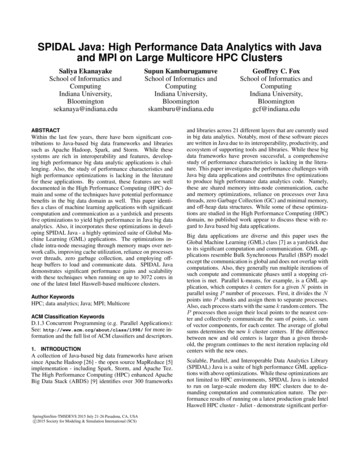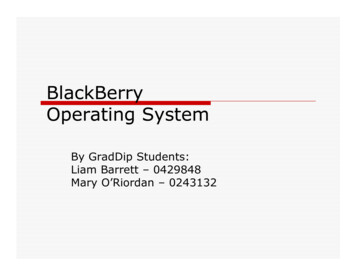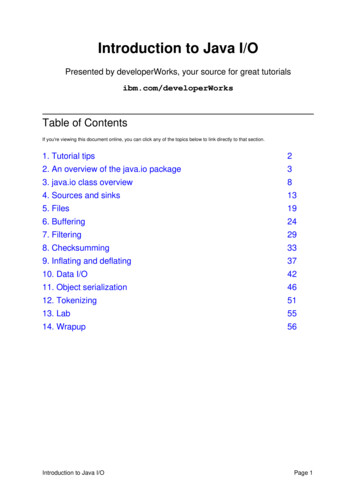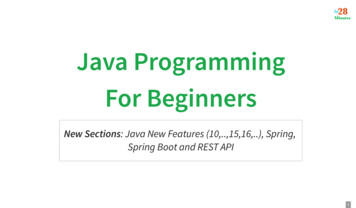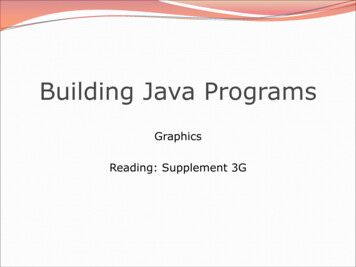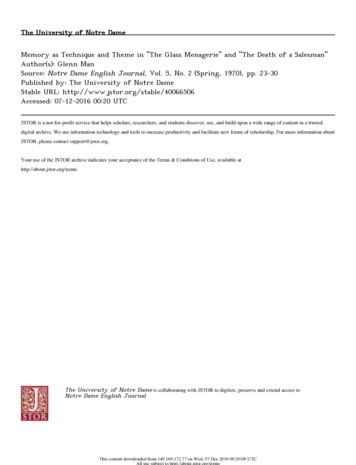
Transcription
Does Java TechnologyHave Memory Leaks?Ed LycklamaChief Technology Officer, KL Group Inc.1105130516, Ed Lycklama1
Overview Garbage collection review What is a memory leak? Common patterns Tools & Demo Q&A Wrap-up1105130516, Ed Lycklama2
Garbage Collection inJava Technology As objects created, stored in Java heap– Set of allocated objects forms a directed graph– Nodes are objects, edges are references GC: remove objects no longer needed– Undecidable in general; use approximation Remove objects no longer reachable– Start search at roots Locals on thread stack Static fields1105130516, Ed Lycklama3
Simple GC ExamplePublic void useless() {MyObject m1 new MyObject();MyObject m2 new MyObject();m1.ref m2;global.ref m2;m1m2“global”return;}now unreachable1105130516, Ed Lycklama4
Garbage Collection Myths GC doesn’t handle reference cycles– Not based on reference counting (e.g. COM) Finalizer is like a destructor– Called when about to be collected Never call it directly– May never be called Depends on free memory, GC implementation– Finalizer may “resurrect” object! Another object makes reference to it1105130516, Ed Lycklama5
What Is a Memory Leak? Allocated– Exists on the heap Reachable– A path exists from some root to it Live– Program may use it along some futureexecution path1105130516, Ed Lycklama6
What Is a Memory Leak?allocatedreachableMemory leak inC/C Memory leakin Javalive1105130516, Ed Lycklama7
C vs. The JavaProgramming Language Memory leak in C – Object allocated but not reachable Malloc/new, forgot about free/delete– Once unreachable, leak can’t be fixed Memory leak in the Java programminglanguage– Object reachable, but not live Reference set, forgot to clear it– Object reachable, but code to fix leak may not be e.g. private field1105130516, Ed Lycklama8
Nodes vs. Edges C , manage nodes and edges– Explicitly add/remove nodes and edges– Dangling edges corrupt memory– Dangling node is a memory leak The Java programming language,manage the edges– Explicitly add nodes/edges, remove edges only– Nodes won’t go away unless it’s cut-offfrom graph1105130516, Ed Lycklama9
Less Common, More Severe Rarer than in C .– GC does most of the work but impact more severe– Rarely a single object, but a whole sub-graph– e.g. in Project Swing technology, path from any UIcomponent to another (parent/child relationship)– Typically subclass, add other references– Single lingering reference can have massivememory impact1105130516, Ed Lycklama10
Need a New Term Loiterer Object remains past its usefulness Distinct from memory leaks in C Some of the native Java libraries haveconventional memory leaks– Programmers using Java technology can’tfix them1105130516, Ed Lycklama11
Lexicon of Loiterers Four main patterns of loitering––––1105130516, Ed LycklamaLapsed listenerLingererLaggardLimbo12
Lapsed Listener Object added to collection, not removed– e.g. event listener, observer– Collection size can grow without bound– Iteration over “dead” objects degradesperformance Most frequent loitering pattern– Swing and AWT have had many– Occurs easily in any large framework C : small loiterer or dangling pointer1105130516, Ed Lycklama13
Lapsed Listener Example Java 2 platform, desktop properties––––1105130516, Ed lkit is a singletonListeners will usually be shorter lifespanListener must callremovePropertyChangeListener() whenit is “being destroyed”14
Lapsed Listener Strategies Ensure add/remove calls are paired Pay attention to object lifecycles Consider implementing a listener registry Beware of framework that claims tohandle cleanup automatically– Understand assumptions made1105130516, Ed Lycklama15
Lingerer Reference used transiently bylong-term object– Reference always reset on next use e.g. associations with menu items e.g. global action or service Not a problem in C – Benign dangling reference1105130516, Ed Lycklama16
Lingerer Example Print action as singleton––––Printable target;call target.doPrint();Target not set to null on completionTarget is a lingering reference Target cannot be GC’ed until next print1105130516, Ed Lycklama17
Lingerer Strategies Don’t use a set of fields to maintain state– Enclose in object Easier to maintain One reference to clean up Draw state diagram– Quiescent state no outgoing references Early exit methods or multi-stage process– Setup; process; cleanup1105130516, Ed Lycklama18
Laggard Object changes state, some referencesstill refer to previous state– Also a hard-to-find bug Common culprits– Changing life-cycle of class (e.g. into a singleton) Constructor sets up state Caches expensive-to-determine object State changes, cache not maintained C : dangling pointer1105130516, Ed Lycklama19
Laggard Example List of files in directory– Maintains several metrics Largest, smallest, most complex file– Change to new directory– Only largest and smallest updated– Reference to most complex is a laggard Won’t notice unless code is coverage tested Memory debugging would uncover it1105130516, Ed Lycklama20
Laggard Strategies Cache cautiously– Only expensive, frequently used calculations Use a profiler to guide you Encapsulate in a single method– Do all calculations in one spot1105130516, Ed Lycklama21
Limbo Reference pinned by long-running thread– References on stack– GC doesn’t do local liveness analysis Common culprits– Thread stall– Expensive setup calls long-running analysis C : placement of destructors1105130516, Ed Lycklama22
Limbo ExampleVoid method() {Biggie big readIt();Item item findIt(big);big null;parseIt(item);} Read file using std.parser Big consumes a lotof memory Item condenses it Iterate over elementsof item Big can’t be GC’eduntil method returns1105130516, Ed Lycklama23
Limbo Strategy Be aware of long-running methods– Profilers can help Pay attention to large allocations thatprecede it– Use a memory debugger to help find them– Add explicit null assignments to assist GC Blocked threads can also be a problem– Use a thread-analysis tool1105130516, Ed Lycklama24
Tools and Techniques ObjectTracker– Lightweight instance tracking infrastructure– Invasive: requires code modification– Find loiterers of a particular class You decide which classes to track Won’t tell you why it loiters– Relies on unique hashcode Will not work in the Java 2 virtual machine May not work in other VM’s1105130516, Ed Lycklama25
Tools and Techniques Memory Debugger–––––1105130516, Ed LycklamaNo code modification requiredMonitor overall heap usageUnderstand allocation activity by classPinpoint excessive object allocationIdentify memory leaks (loiterers)26
Tools and Techniques Finding Loiterers in a Memory Debugger– Track all instances of all classes– Each instance: Time allocation occurred References (incoming and outgoing) Stack back-trace of allocation– Visualize reference graph back to roots– Checkpoint creation times1105130516, Ed Lycklama27
Demo1105130516, Ed Lycklama28
Questions?1105130516, Ed Lycklama29
Wrap-Up Most non-trivial Java technology-basedprograms have loiterers– GC is not a silver bullet– Manage the edges, not the nodes Loiterers different than memory leaks– Harder to find– Less frequent, but generally much larger1105130516, Ed Lycklama30
Wrap-Up Object lifecycles are key Build memory-management frameworkinto your development practices Tools are indispensable for finding outwhy loiterers are occurring1105130516, Ed Lycklama31
Contact Info These slides and ObjectTracker at:http://www.klgroup.com/javaone See JProbe at KL Group’s booth #727 Contact me: eal@klgroup.com1105130516, Ed Lycklama32
1105130516, Ed Lycklama33
Java Technology As objects created, stored in Java heap - Set of allocated objects forms a directed graph - Nodes are objects, edges are references GC: remove objects no longer needed - Undecidable in general; use approximation Remove objects no longer reachable - Start search at roots Locals on thread stack .



